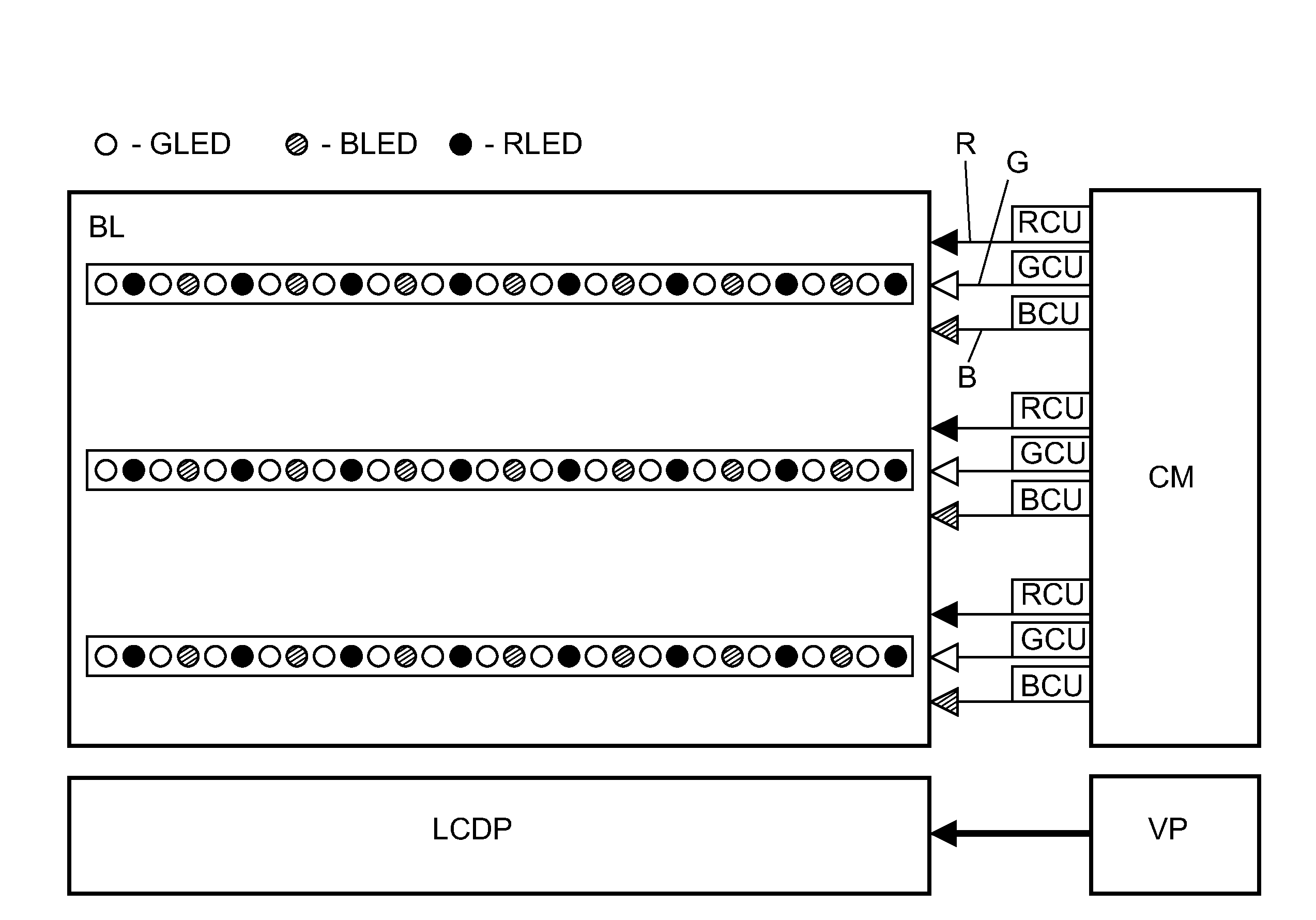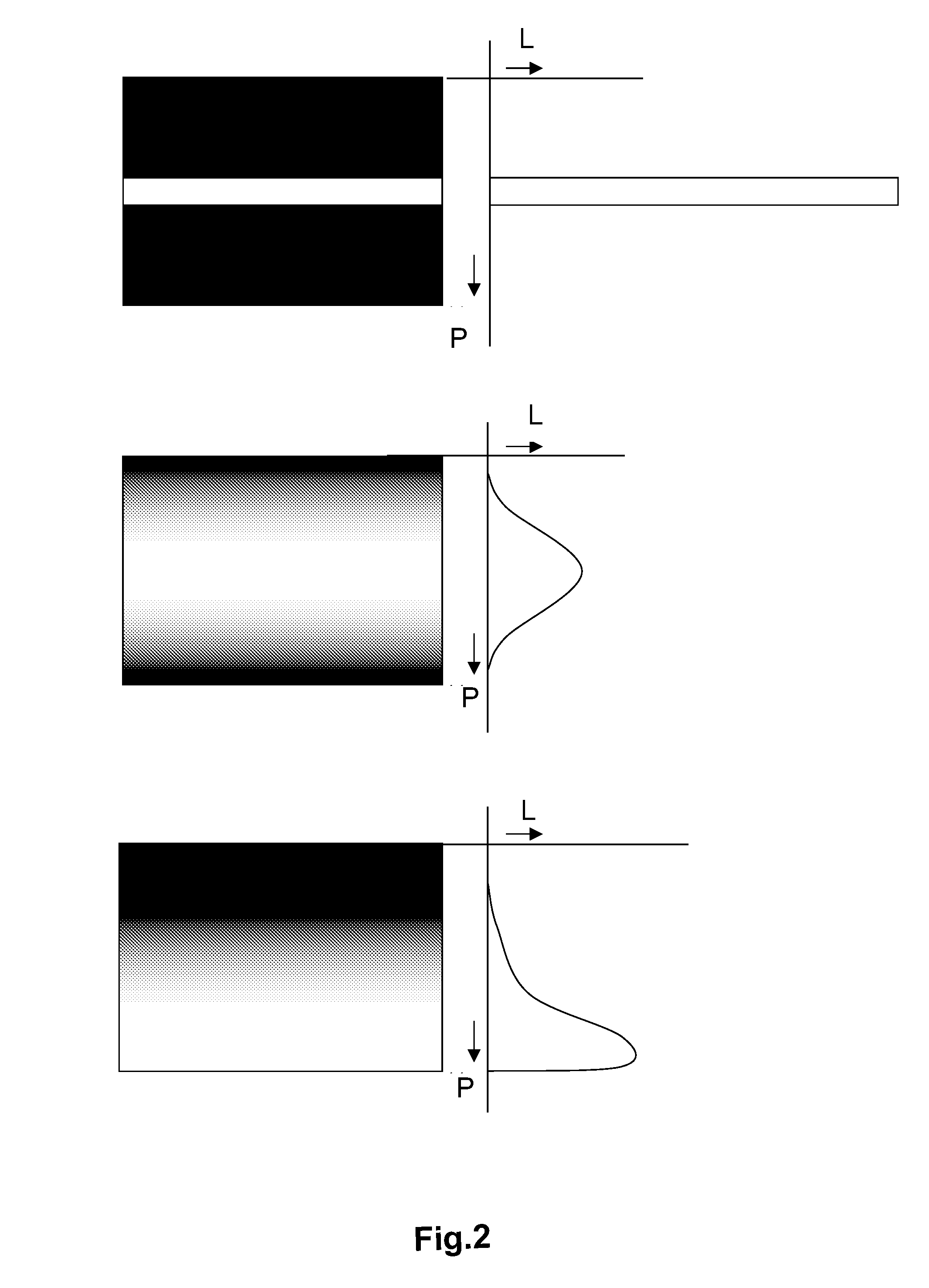Liquid crystal display device and method for driving a liquid crystal display device
- Summary
- Abstract
- Description
- Claims
- Application Information
AI Technical Summary
Benefits of technology
Problems solved by technology
Method used
Image
Examples
first embodiment
[0027]FIG. 1 shows a basic representation of a liquid crystal display device according to the invention. The liquid crystal display device comprises a LCD display panel LCDP, optionally a video processing unit VP, a backlight means BL and a control means CM for controlling the backlight means BL. The backlight means BL comprises a plurality of colored light-emitting device LED, i.e. green LEDs GLED, red LEDs RLED and blue LEDs BLED. The LEDs are arranged in rows or horizontal stripes. Although in FIG. 1 only three rows of LEDs are depicted, the backlight means BL may comprise more than merely three rows LEDs. Each row of LEDs or each horizontal stripe of LEDs are driven by a control unit for red RCU, a control unit for green GCU and control unit for blue BCU. In other words, the control units RCU, GCU and BCU are associated to each of the rows of LEDs for controlling the colored LEDs in that row. The LCD panel LCDP is used to display the images and video signals from the internal or...
second embodiment
[0032]FIG. 4 shows a diagram of the light output L of red R, green G and blue B sub-pixels for double-pulse scanning backlight according to a Instead of merely one scanning pulse as described according to FIG. 3, the double-pulse scanning backlight according to FIG. 4 has a primary and a secondary pulse P, S at t1 and t3 within one time period T, respectively. Accordingly, the primary pulse P will comprise a primary green pulse PG, a primary red pulse PR and a primary blue pulse PB while the secondary pulse S will comprise a secondary green pulse SG, a secondary red pulse SR and a secondary blue pulse SB. Preferably, the primary pulses PG, PR and PB are aligned at t1, i.e. immediately before the liquid crystal cells of the LCD panel are addressed by the next frame of the video data corresponding to that moment when the liquid crystal cells are optimally settled. On the other hand, the secondary pulse SG, SR, SB are aligned in the middle of two subsequent primary pulses P, i.e. at t...
third embodiment
[0034]FIG. 5 shows a diagram of a double-pulse scanning backlight according to a Here, the red R, green G and blue B pulses of the primary and secondary pulse P, S of the double-pulse scanning are aligned at the centers of the respective pulses, i.e. at t4, t5, respectively. Hence, by such an alignment, the blurring on various edges of objects is now symmetrical.
[0035]FIG. 6 shows a diagram to illustrate the primary and secondary pulses of a double-pulse scanning backlight according to a fourth embodiment. Here, the duty cycles of the red R, blue B and green G sub-pixels correspond to each other to enable a bright and sharp exposure of the primary pulse wherein the centers of the duty cycles are aligned at t4. The duty cycles of the red R, green G and blue B sub-pixels are different for the secondary pulse and the centers of the red R, green G and blue B pulses are aligned at t5 as described according to the third embodiment. By providing different duty cycles for the secondary sub...
PUM
 Login to View More
Login to View More Abstract
Description
Claims
Application Information
 Login to View More
Login to View More - R&D
- Intellectual Property
- Life Sciences
- Materials
- Tech Scout
- Unparalleled Data Quality
- Higher Quality Content
- 60% Fewer Hallucinations
Browse by: Latest US Patents, China's latest patents, Technical Efficacy Thesaurus, Application Domain, Technology Topic, Popular Technical Reports.
© 2025 PatSnap. All rights reserved.Legal|Privacy policy|Modern Slavery Act Transparency Statement|Sitemap|About US| Contact US: help@patsnap.com



